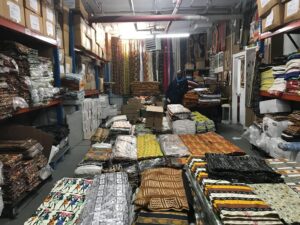For the people of West Africa, colorful fabrics are an important cultural touchstone. Two stores in the South Bronx are helping immigrants from that part of the world access the brightly colored textiles that are popular in their homelands, and helping them retain a sense of cultural identity in their new home.
(Para leer una version del articulo “Telas y colores Africanas en el sur del Bronx” en español, vaya a esta versión.)
Zia Gulraiz, the manager of Holland Textiles on Third Ave. in Melrose, says that the colors and patterns of the fabrics his store sells represent the borough’s different African cultures.
“Nigerians probably look for combinations of yellows and reds and blues with orange,” said Guiraiz. “The Ghanaians will look for greens and browns, or greens with orange,” whereas immigrants from the Ivory Coast, Guinea and Gambia “will prefer whites with purples, and combinations of greens, reds, and yellows. The Congolese are different and will go for very bright colors.”
According to a study by the Pew Research Center, the number of African immigrants in the US has doubled in each decade since the 1970s. Their mark in New York City neighborhoods like Harlem’s Le Petit Senegal has been profound. Data from the city census shows that about 12% of all new immigrants in Mott Haven, Melrose, Port Morris, Longwood and Hunts Point are from various countries in West Africa.
Gulraiz, who is from Pakistan, was hired to run the local storefront seven years ago by Belgium-based Holland Textiles, the largest distributor of African textiles in Europe and North America. Holland Textiles is the exclusive distributor of products from Vlisco, a Dutch company that has been producing and selling textiles adorned with Western Africa colors and patterns since the 1800s. Their clothes start at $95 locally.
Most of Gulraiz’s clients are immigrants from Western Africa who live in the Bronx and want fabrics that they would find back home.

Holland Textiles’ customers use their fabrics to make a variety of clothing. Many of them hire professional tailors like Djourned Titikpina “Titi”, who works on the second floor of the Holland Textile’s storefront. Titi said his fabrics can be used for products ranging from dresses to decorations, curtains, cushions, and covers. Most oare made with cotton, although the most expensive and sought-after are made from silk.
Another West African entrepreneur making a living from the textiles of his homeland, Moctar Yara, opened a storefront in Harlem in 1999, but high rents forced him to close the shop. Yara, who immigrated to New York from Mali three decades ago, now manages the business from a warehouse in Port Morris, from which he sells his fabrics across the continent. Much of the time he sells at conventions for textile vendors.
Most of Yara’s clients are from California, but his reach is expanding to include a buyer from Colombia who makes cushions from Yara’s textiles, and another regular customer from Brazil.
With 34 years of experience as a tailor, Yara says describes his work as being fueled by sentiment and love.” While working on a wedding dress, he thumbed through photos of his clients on Instagram, proudly showing off various garments he had made over the years, and which customers had worn for “the most important events of their lives.”
Yara’s prices differ depending on the amount of time he spends working on a piece, as well as its complexity. His rates range from under $100 for a few hours of work, but thousands for elaborate jobs that can take months.
Given the cultural importance of clothing for West Africans, Titi said, producing quality threads for their growing community in the Bronx is a rewarding way to keep a connection with their past, and share it with his compatriots.
“We are colorful people,” said Titi.

